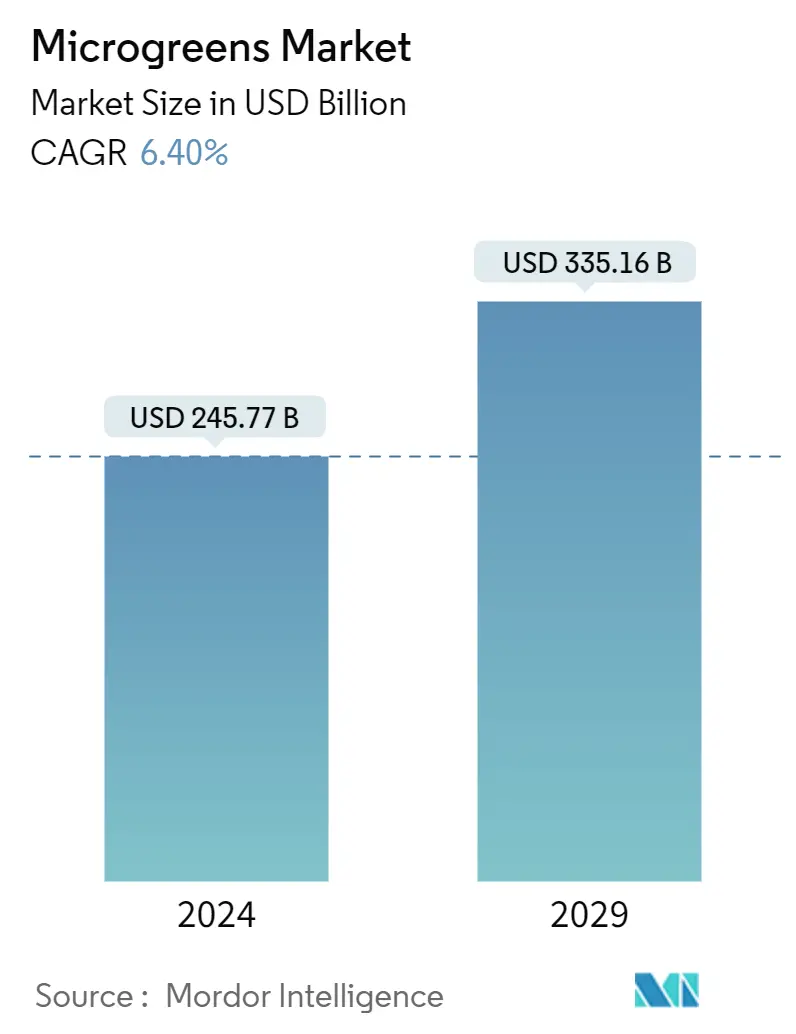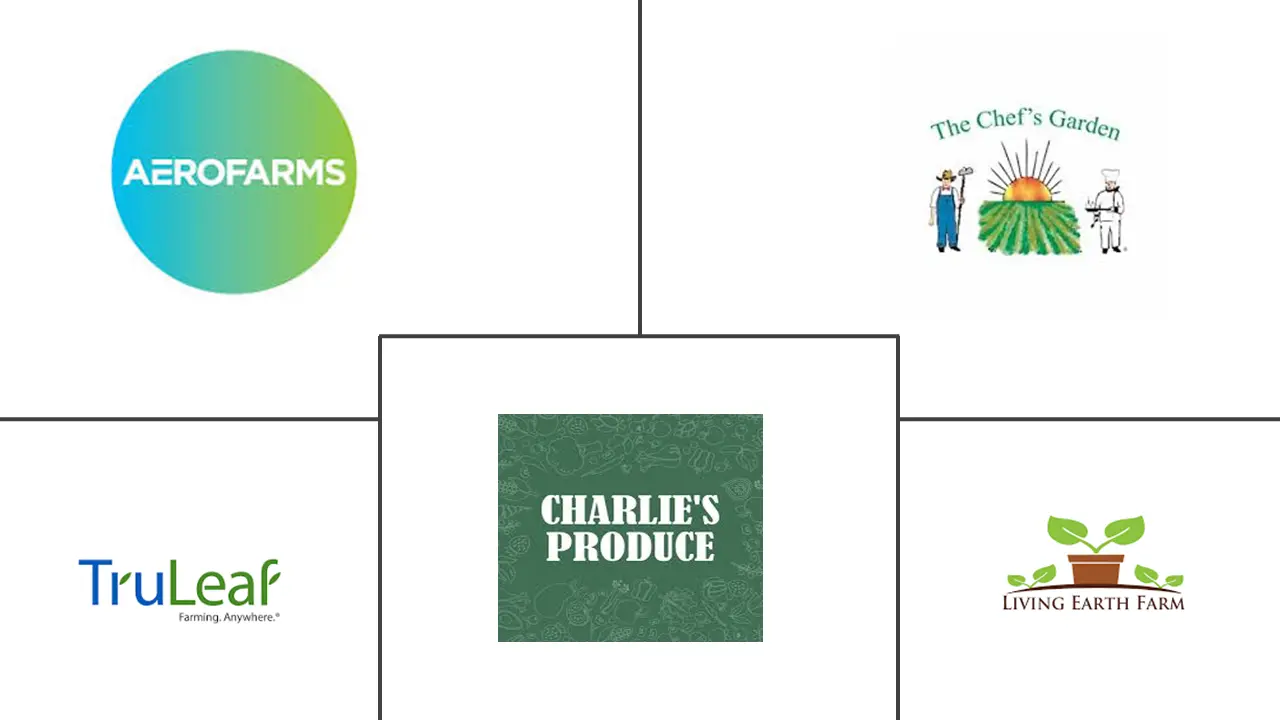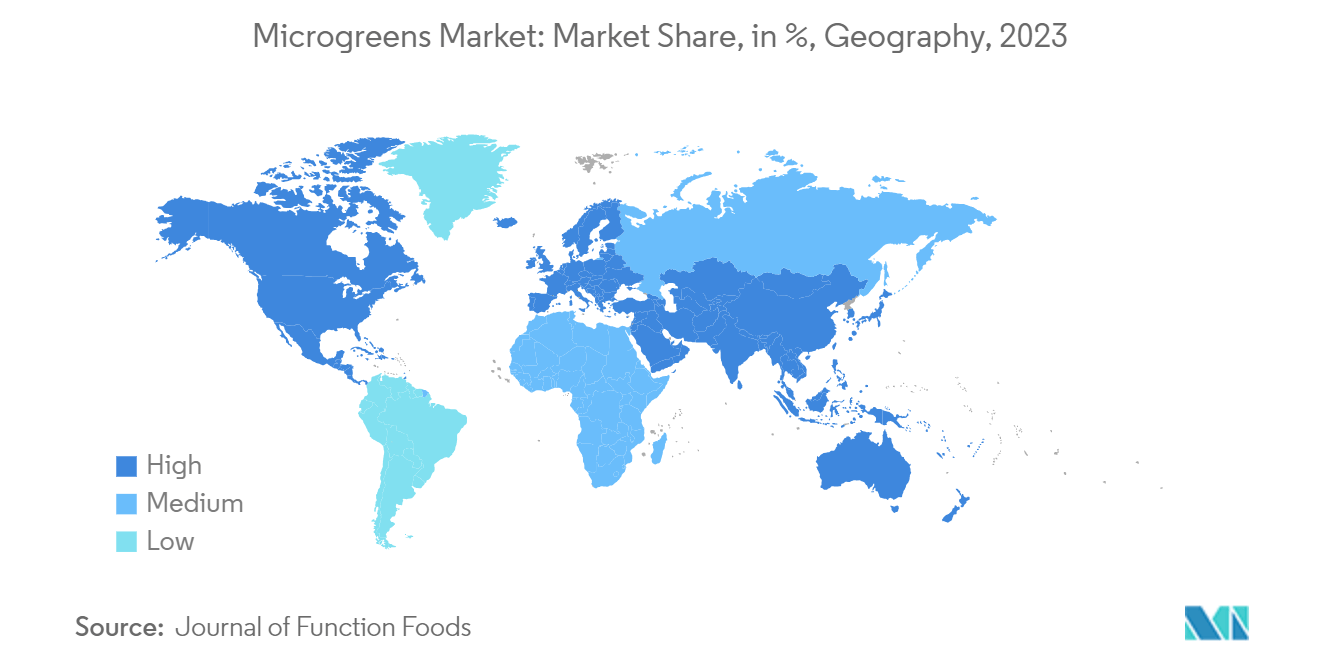Microgreens Market Size

| Study Period | 2019 - 2029 |
| Market Size (2024) | USD 245.77 Billion |
| Market Size (2029) | USD 335.16 Billion |
| CAGR (2024 - 2029) | 6.40 % |
| Fastest Growing Market | Asia Pacific |
| Largest Market | North America |
| Market Concentration | Low |
Major Players
*Disclaimer: Major Players sorted in no particular order |
Microgreens Market Analysis
The Microgreens Market size is estimated at USD 245.77 billion in 2024, and is expected to reach USD 335.16 billion by 2029, growing at a CAGR of 6.40% during the forecast period (2024-2029).
- Microgreens are small, tender vegetable greens used to enhance the color, texture, and flavor of various dishes, including pasta, pizza, omelets, and salads. Their robust aromatic flavor, diverse range of colors, and textures make them popular in culinary applications. Consuming microgreens is associated with health benefits such as weight management, prevention of chronic medical conditions, immunity boosting, and mental health improvement.
- The global trend towards healthier eating habits and increased nutritional awareness continues to drive the microgreens market. Consumers, particularly in urban areas, have become more informed about the high nutrient density of microgreens compared to their mature counterparts. A study published in the International Journal of Home Science found that microgreen varieties contained up to 40 times more nutrients than their mature plant equivalents. Consequently, major supermarket chains in countries such as the United States, United Kingdom, and Australia have expanded their microgreens offerings.
- To meet the growing demand, investments are being made in advanced hydroponic systems that utilize artificial intelligence and smart sensors to optimize growth conditions. Aa a result, there is significant growth in greenhouse hectares for cultivation. For instance, according to the European Commission, the area under greenhouses in Spain reached 25,000 ha and in Italy 18,500 ha in 2023. Companies like Freight Farms are maximizing output by integrating microgreens into their production cycles in vertical farms, utilizing existing space. These microgreens can yield between 0.001 to 0.002 metric tons per tray, generating significant revenue.
- While greens and herbs or microgreens are among the most profitable crops, the limited varieties available for indoor farming may restrict market growth. Although hydroponics farming holds significant potential, its progress and adoption in agriculture have been relatively slow.
- Broccoli, lettuce, arugula, and basil are among the essential microgreens cultivated worldwide using hydroponics and vertical farming techniques. The demand for microgreens is increasing in developed countries, as they can be cultivated indoors throughout the year. According to the United States Fresh Produce Association, the likelihood of consumers purchasing broccoli microgreens increases with income and age. With a growing population, microgreens offer a nutritious and sustainable means to diversify the food supply, which is expected to drive market growth.
Microgreens Market Trends
Rise in Adoption of Indoor Farming
- The increasing global population has led to a rise in food demand, prompting farmers to adopt high-tech methods like indoor farming due to the decrease in productive land. Concurrently, growing health consciousness has encouraged people to consume nutrient-rich diets, further promoting the adoption of indoor farming practices.
- The increased acceptance of agricultural mechanization and advanced knowledge of high-tech farming techniques such as hydroponics, aeroponics, and aquaponics are expected to drive the expansion of the microgreens industry. As consumers worldwide shift towards healthier diets, the demand for microgreens is increasing, with production expected to rise in the coming years. This growing adoption of protected cultivation has contributed to moderate market growth.
- The culinary industry has incorporated microgreens for their flavor enhancement and visual appeal. Chefs increasingly utilize microgreens as garnishes or key ingredients, boosting their popularity in restaurants and among home cooks. This trend is reinforced by consumer education initiatives that emphasize the versatility and health benefits of microgreens, further promoting the adoption of microgreen farms.
- In Canada, greenhouse vegetable production, including microgreens, has seen a steady increase, with the multi-decade growth trend expected to continue. Notably, in 2023, provinces such as Ontario and British Columbia led in harvested areas of greenhouse-grown vegetables, with 1,590 hectares and 340 hectares, respectively.

North America is the Largest Market for Microgreens
- North America held the largest share of the microgreens market in 2023. Increased awareness of health benefits and balanced diets has led people in this region to incorporate green vegetable salads and organic-based food items, including microgreens, into their diets, expanding the market. United States growers have achieved large-scale microgreens production through improved indoor and vertical farming practices.
- Most North American microgreens production occurs in controlled environment agriculture facilities, with major urban centers like New York, Toronto, and Chicago at the forefront. The market has attracted significant venture capital investment, indicating strong growth potential. In March 2023, Canada's first hands-free vertical farm opened in British Columbia, utilizing touchless technology from seeding to harvest.
- Consumer awareness and health consciousness have significantly influenced the growth of the microgreens market in the USA. The United States Department of Agriculture reported that the average United States household's spending on vegetables increased by over 23% between 2019 and 2023. As consumers prioritize healthy eating and seek functional foods, the demand for microgreens has risen, establishing them as a premium, health-focused product in the market.
- Many retailers in the United States supply "Certified Naturally Grown" microgreen seeds to local restaurants and farmers, which can be grown hydroponically and through vertical farming. Canadian farmers prefer indoor agriculture over greenhouse farming for microgreens cultivation due to lighting requirements. Indoor production reduces many pest and disease issues associated with outdoor growing. Consequently, farmers are entering this market to meet the increasing global demand for microgreens.

Microgreens Industry Overview
The microgreens market is fragmented and highly competitive due to the presence of international and regional players. The key players in the microgreens market include Farmbox Greens LLC, The Chef’s Garden Inc., Aerofarms LLC, Living Earth Farms, and Good Leaf Farms. These players are adopting product launches and expansion as key strategies for growth in the microgreens market.
Microgreens Market Leaders
-
Charlies Produce (Farm Box Greens)
-
AeroFarms LLC
-
Chef's Garden Inc.
-
Truleaf (GoodLeaf Farms)
-
Living Earth Farms
*Disclaimer: Major Players sorted in no particular order

Microgreens Market News
- May 2023: AeroFarms, a Certified B Corporation and a prominent figure in indoor vertical farming took a significant step forward by launching a nationwide expansion through a collaboration with Amazon Fresh. This partnership aims to enhance the high-tech consumer grocery experience.
- February 2023: Good Leaf Farm, an indoor agriculture company, joined forces with Unfold, a leading seed, and digital solutions company, to introduce premium lines of vertically farmed spinach and assorted leafy greens through Unfold's Innovation Partner Program.
- August 2022: AeroFarms significantly increased its retail presence and accessibility by extending its reach to 160 Fresh Market stores across 22 states. Customers at these stores could now enjoy AeroFarm's delectable microgreens and baby watercress.
Microgreens Market Report - Table of Contents
1. INTRODUCTION
1.1 Study Assumptions and Market Definition
1.2 Scope of the Study
2. RESEARCH METHODOLOGY
3. EXECUTIVE SUMMARY
4. MARKET DYNAMICS
4.1 Market Overview
4.2 Market Drivers
4.2.1 Rising Health Consciousness and Demand for Nutrient-Dense Foods
4.2.2 Growth of Urban Farming and Indoor Agriculture
4.2.3 Increasing Adoption in Fine Dining and Culinary
4.3 Market Restraints
4.3.1 High Production Costs and Limited Scalability
4.3.2 Short Shelf Life and Storage Challenges
4.4 Value Chain Analysis
5. MARKET SEGMENTATION
5.1 Type
5.1.1 Broccoli
5.1.2 Lettuce and Chicory
5.1.3 Arugula
5.1.4 Basil
5.1.5 Fennel
5.1.6 Carrots
5.1.7 Sunflower
5.1.8 Radish
5.1.9 Peas
5.1.10 Other Types
5.2 Farming
5.2.1 Indoor Farming
5.2.2 Vertical Farming
5.2.3 Commercial Greenhouses
5.2.4 Other Farming
5.3 Growth Medium
5.3.1 Peat Moss
5.3.2 Soil
5.3.3 Coconut Coir
5.3.4 Tissue Paper
5.3.5 Other Growth Mediums
5.4 Distribution Channel
5.4.1 Hypermarkets/Supermarkets
5.4.2 Restaurants
5.4.3 Other Distribution Channels
5.5 Geography
5.5.1 North America
5.5.1.1 United States
5.5.1.2 Canada
5.5.1.3 Mexico
5.5.1.4 Rest of North America
5.5.2 Europe
5.5.2.1 Netherlands
5.5.2.2 Spain
5.5.2.3 Germany
5.5.2.4 France
5.5.2.5 Rest of Europe
5.5.3 Asia-Pacific
5.5.3.1 China
5.5.3.2 India
5.5.3.3 Singapore
5.5.3.4 Australia
5.5.3.5 Rest of Asia-Pacific
5.5.4 South America
5.5.4.1 Brazil
5.5.4.2 Chile
5.5.4.3 Argentina
5.5.4.4 Rest of South America
5.5.5 Middle East & Africa
5.5.5.1 Algeria
5.5.5.2 Saudi Arabia
5.5.5.3 Egypt
5.5.5.4 South Africa
5.5.5.5 Rest of Middle East & Africa
6. COMPETITIVE LANDSCAPE
6.1 Most Adopted Strategies
6.2 Market Share Analysis
6.3 Company Profiles
6.3.1 AeroFarms LLC
6.3.2 Truleaf (GoodLeaf Farms)
6.3.3 Living Earth Farm
6.3.4 Charlies Produce (Farm Box Greens)
6.3.5 Jiangsu Skyplant Greenhouse Technology Co. Ltd
6.3.6 Shanghai Dehuan Industry Co. Ltd
6.3.7 Chef's Garden Inc.
6.3.8 Madar Farms
6.3.9 Metro Microgreens
6.3.10 Gotham Greens
7. MARKET OPPORTUNITIES AND FUTURE TRENDS
Microgreens Industry Segmentation
Microgreens are shoots of salad vegetables picked just after the first leaves have developed. They have fully grown cotyledon leaves and, usually, one pair of very small, partially produced true leaves. They are cultivated using various kinds of farming, such as vertical farming, indoor farming, and commercial greenhouses. The microgreens market is segmented by type (broccoli, lettuce and chicory, arugula, basil, fennel, carrots, sunflower, radish, peas, and other types), farming (indoor farming, vertical farming, commercial greenhouses, and other farming), growth medium (coconut coir, peat moss, soil, tissue paper, and other growth mediums), distribution channel (hypermarkets/supermarkets, restaurants, and other distribution channels), and geography (North America, Europe, Asia-Pacific, South America, and Middle East & Africa). The report offers the market size and forecasts in terms of value (USD) and volume (Metric Tons) for the above-mentioned segments.
| Type | |
| Broccoli | |
| Lettuce and Chicory | |
| Arugula | |
| Basil | |
| Fennel | |
| Carrots | |
| Sunflower | |
| Radish | |
| Peas | |
| Other Types |
| Farming | |
| Indoor Farming | |
| Vertical Farming | |
| Commercial Greenhouses | |
| Other Farming |
| Growth Medium | |
| Peat Moss | |
| Soil | |
| Coconut Coir | |
| Tissue Paper | |
| Other Growth Mediums |
| Distribution Channel | |
| Hypermarkets/Supermarkets | |
| Restaurants | |
| Other Distribution Channels |
| Geography | |||||||
| |||||||
| |||||||
| |||||||
| |||||||
|
Microgreens Market Research FAQs
How big is the Microgreens Market?
The Microgreens Market size is expected to reach USD 245.77 billion in 2024 and grow at a CAGR of 6.40% to reach USD 335.16 billion by 2029.
What is the current Microgreens Market size?
In 2024, the Microgreens Market size is expected to reach USD 245.77 billion.
Who are the key players in Microgreens Market?
Charlies Produce (Farm Box Greens), AeroFarms LLC, Chef's Garden Inc., Truleaf (GoodLeaf Farms) and Living Earth Farms are the major companies operating in the Microgreens Market.
Which is the fastest growing region in Microgreens Market?
Asia Pacific is estimated to grow at the highest CAGR over the forecast period (2024-2029).
Which region has the biggest share in Microgreens Market?
In 2024, the North America accounts for the largest market share in Microgreens Market.
What years does this Microgreens Market cover, and what was the market size in 2023?
In 2023, the Microgreens Market size was estimated at USD 230.04 billion. The report covers the Microgreens Market historical market size for years: 2019, 2020, 2021, 2022 and 2023. The report also forecasts the Microgreens Market size for years: 2024, 2025, 2026, 2027, 2028 and 2029.
What are the challenges faced by new entrants in the Microgreens Market?
The challenges faced by new entrants in the Microgreens Market are a) Competition b) Establishing consistent supply chains c) Consumer awareness
What are the challenges faced by new entrants in the Microgreens Market?
The challenges faced by new entrants in the Microgreens Market are a) Competition b) Establishing consistent supply chains c) Consumer awareness
Microgreens Industry Report
The global microgreens market is experiencing significant growth, driven by a surge in consumer health consciousness and demand for nutrient-rich, fast-growing greens. Favored for both residential and commercial purposes, microgreens thrive in controlled environments like indoor vertical farms and commercial greenhouses. The market diversification includes various types, such as broccoli, arugula, radish, and basil, each chosen for their unique health benefits and cultivation ease. These greens are available through various distribution channels, including retail stores, online platforms, farmers markets, and supermarkets/hypermarkets, and are popular in culinary settings as garnishes and flavor enhancers. Regionally, North America leads due to advanced farming technologies and high health food expenditure, with Europe and Asia-Pacific also showing promising growth through sustainable farming practices. The expansion in the microgreens market reflects broader consumer trends towards health-focused diets and sustainable food production, supported by continual innovations in farming methods and product offerings. For in-depth analysis and market forecasts, a report by Mordor Intelligence™ offers a detailed overview. Get a sample of this industry analysis as a free report PDF download.



